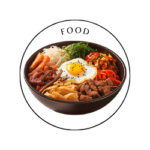 Mind
Mind
- Digital and Modern Well-being
- Mental Health and Emotional Well-being
- Mind-Body Connection and Holistic Health
- Parenting and Family
- Personal Growth and Development
- Relationships and Social Well-being
- Stress and Relaxation
- Therapeutic and Creative Practices
- Trauma and Recovery
- Work, Productivity, and Discipline
 Body
Body
 Fitness
Fitness
 Food
Food
 Beauty
Beauty
Mindful Cooking for Special Diets

Mindful Cooking for Special Diets: Nourishing Body and Soul
Cooking mindfully for special diets is an art that not only focuses on nutrition but also cultivates a deeper connection with food. Whether due to health needs, ethical beliefs, or personal preferences, special diets require attention and creativity. This article explores mindful cooking techniques tailored for various dietary restrictions, helping you to nourish your body and soul while enjoying the process.
1. Understanding Mindful Cooking
Mindful cooking is about being present in the kitchen. It encourages you to engage your senses and appreciate the process of preparing food. When cooking mindfully, you can:
- Focus on Ingredients: Pay attention to the colors, textures, and aromas of the ingredients.
- Reduce Stress: Embrace the calming effects of cooking, allowing it to serve as a form of meditation.
- Savour the Moment: Enjoy the fruits of your labor by taking time to taste and appreciate each dish.
Benefits of Mindful Cooking:
- Enhances your appreciation for food.
- Improves cooking skills and creativity.
- Promotes healthier eating habits.
- Supports emotional well-being and reduces anxiety.
2. Special Diets Overview
Various special diets cater to specific health needs or lifestyle choices. Here are some common types:
- Gluten-Free: Avoids gluten, a protein found in wheat, barley, and rye, for those with celiac disease or gluten sensitivity.
- Vegetarian/Vegan: Excludes meat and animal products for ethical, health, or environmental reasons.
- Paleo: Focuses on whole foods that our ancestors would have eaten, avoiding processed foods, grains, and dairy.
- Ketogenic: High-fat, low-carbohydrate diet designed to promote ketosis for weight loss or improved metabolic health.
- Low FODMAP: Aims to reduce fermentable carbohydrates that may trigger digestive issues.
3. Mindful Cooking Techniques for Special Diets
a. Planning and Preparation
- Meal Planning: Set aside time each week to plan meals. This helps ensure that you have all necessary ingredients and can maintain a balanced diet.
- Grocery Shopping Mindfully: Choose fresh, local, and seasonal produce whenever possible. Read labels carefully to avoid hidden ingredients that do not align with your dietary needs.
b. Cooking Methods
- Batch Cooking: Prepare large quantities of meals or components (like grains or legumes) and store them for the week. This saves time and ensures you have nutritious options readily available.
- Creative Substitutions: Explore ingredient swaps to make recipes more suitable for your diet. For example:
- Gluten-Free: Use almond flour or chickpea flour instead of wheat flour.
- Vegan: Substitute eggs with flaxseed meal or applesauce in baking.
- Low-Carb: Replace pasta with spiralized vegetables or cauliflower rice.
c. Savoring the Experience
- Mindful Eating: After cooking, take a moment to appreciate your meal. Sit down without distractions, focus on each bite, and notice the flavors and textures.
- Gratitude Practice: Before eating, express gratitude for the ingredients, the effort involved in preparing the meal, and the nourishment it provides.
4. Sample Mindful Recipes for Special Diets
Gluten-Free Quinoa Salad
Ingredients:
- 1 cup quinoa
- 2 cups water
- 1 cup cherry tomatoes, halved
- 1 cucumber, diced
- 1/4 cup red onion, finely chopped
- Fresh herbs (parsley, mint)
- Olive oil, lemon juice, salt, and pepper to taste
Instructions:
- Rinse quinoa under cold water. Combine with water in a saucepan and bring to a boil. Reduce heat and simmer until water is absorbed (about 15 minutes).
- In a large bowl, combine cooked quinoa, tomatoes, cucumber, onion, and herbs.
- Drizzle with olive oil and lemon juice. Season with salt and pepper. Toss gently and enjoy.
Vegan Chickpea Curry
Ingredients:
- 1 can chickpeas, drained and rinsed
- 1 can coconut milk
- 1 onion, chopped
- 2 garlic cloves, minced
- 1 tbsp ginger, grated
- 2 tbsp curry powder
- Fresh spinach or kale
Instructions:
- Sauté onion, garlic, and ginger in a pan until softened.
- Stir in curry powder and cook for another minute.
- Add chickpeas and coconut milk, simmer for 10-15 minutes.
- Stir in spinach until wilted. Serve with brown rice or quinoa.
5. Mindful Cooking as a Community Practice
Cooking can be a social activity that fosters connection and community. Consider:
- Cooking Classes: Join or host classes focused on special diets, where participants can learn and share recipes.
- Potluck Gatherings: Invite friends to bring dishes that align with their dietary choices, promoting variety and inclusivity.
- Online Communities: Engage with others on social media platforms or forums focused on special diets. Share experiences, recipes, and tips for mindful cooking.
6. Conclusion
Mindful cooking for special diets allows you to embrace food in a way that is both nourishing and fulfilling. By focusing on the process and choosing ingredients thoughtfully, you can create meals that not only meet dietary needs but also promote well-being. Whether you’re cooking for yourself or sharing with others, remember that the journey of preparing food can be as rewarding as the meal itself. Embrace the art of mindful cooking, and enjoy the myriad benefits it brings to your health and happiness!
